Find info on your Singer sewing machine | #LRCrafts - DIY Passion: if you can think it, you can make it
Enter Serial Number:As someone who’s had their fair share of struggles trying to figure out the model of a vintage Singer sewing machine using just the serial number, I wanted to make things easier for fellow enthusiasts.
Here you can quickly identify key information about your machine, like its model, production year or factory, with just a few clicks. Just input your machine’s serial number and get the data we collected about it.
The data we collected based on Singer’s historical records, as revised by the company in 2005, checked with information from reliable sources such as ISMACS. While we strive for accuracy, it’s important to note that the results may not always be perfect due to the age and origin of the records or the difficulty of mantaining a database of millions of machines.
Please if you find inaccuracies or missing data, drop a comment or contact us!
Was this article helpful / interesting?YesNoTable of contents
About Singer sewing machines serial numbers
Where to find the serial number
If you’re the proud owner of a vintage Singer sewing machine, you may have noticed a series of numbers stamped or engraved somewhere on its body. Singer have always marked its machines with serial numbers, ever since the beginning of their production.
First things first: where can you find the serial number on your Singer sewing machine? Depending on the model and age of your machine, the serial number can be located in various places. Common locations include:
- Older machines. In some cases, particularly for older machines, the serial number may also be stamped on the throat plate, which is the metal plate covering the bobbin area. This location can vary depending on the machine model.
- Early Models (pre-1950s). For most machines manufactured before the 1950s, the serial number is often located on top of the bed at the front right corner. This area is near the handwheel and may be stamped or engraved into the metal surface.
- Later Models. For machines produced after the 1950s, the serial number is commonly found on a raised pad underneath the bed, around the edge. This pad may be located on the bottom of the machine and is often accessible by tilting or removing the machine from its base.
When searching for the serial number, it’s important to inspect these areas carefully, as the numbers may be faint or obscured by dirt and grime. Taking a close look under good lighting conditions can help you locate the serial number and unlock valuable information about your Singer sewing machine’s history.
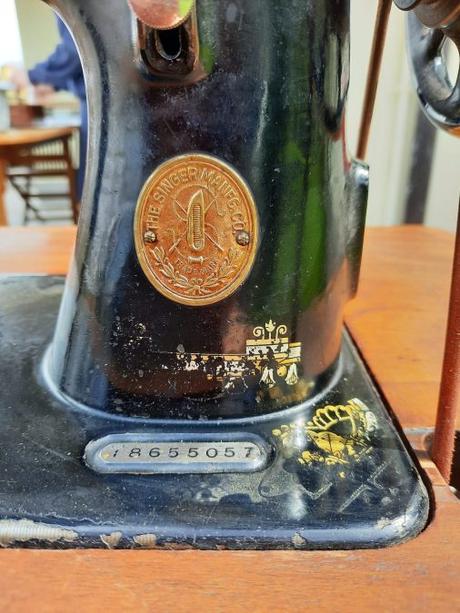 A silver plate usually hosts the Singer sewing machine serial number
A silver plate usually hosts the Singer sewing machine serial number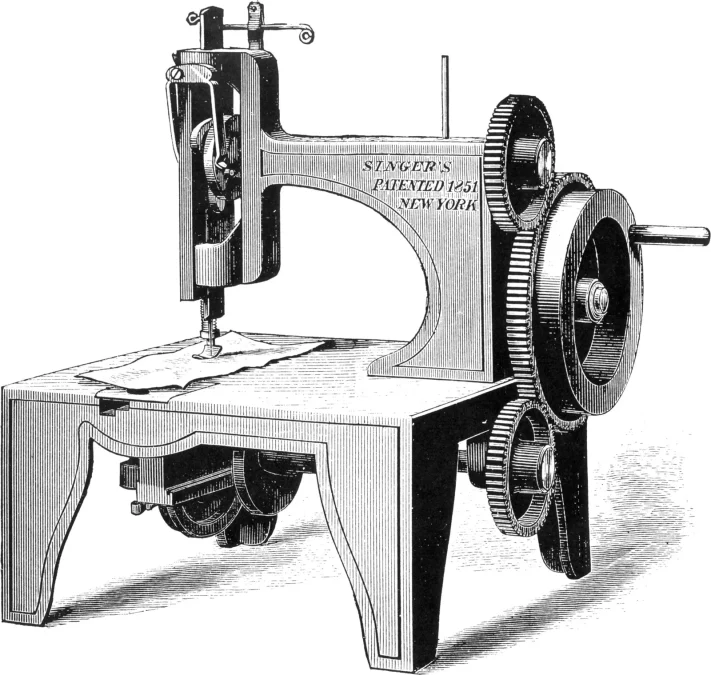 Isaac M. Singer's first sewing machine, as patented in 1851, illustrated in "Genius Rewarded or, The Story of the Sewing Machine", 1880
Isaac M. Singer's first sewing machine, as patented in 1851, illustrated in "Genius Rewarded or, The Story of the Sewing Machine", 1880What can you learn from the serial number?
Just at the first glance, the serial number itself can give you valuable information.
If the serial number consists only of numbers, it suggests that the machine was manufactured before 1900. These serial numbers typically follow a simple sequential numbering system, with each machine assigned a unique number. It’s important to note that for Singer sewing machines manufactured before 1900, there are no factual records available. Instead, estimates of production years are made based on ranges of serial numbers. While these estimates are generally regarded as fairly accurate, they are not definitive records.
Until 1889, most Singer sewing machines carried two numbers adjacent to each other, with the larger of these numbers considered the relevant serial number.
About the factory, between 1870 and 1900 all machines were made at either the Elizabethport or Kilbowie factories. It’s likely that a system of issuing blocks of numbers to each factory was used to manage serial number allocation. However, there is no breakdown available indicating which numbers were allocated to each factory.
If the serial number starts with one or two letters followed by numbers, it indicates that the machine was manufactured after 1900. These letters often represent the factory location.
These letters were used for pre-production planning purposes, where large batches of numbers were pre-allocated to ensure sufficient materials and parts were ordered in advance. The serial numbers themselves were not used on machines until months or even years after these allocation dates, and sometimes they may not have been used at all. Due to changes in order situations and unforeseen circumstances, errors in serial number records are common.
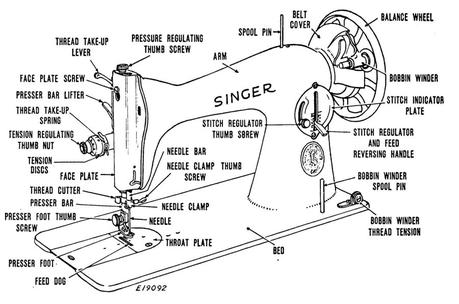 Diagram of the different parts of a Singer class 15
Diagram of the different parts of a Singer class 15This is why in serial number records you can find online, even in our database, you find an “allocation date“: on that specific date, following the information we have from historical sources, a certain batch of serial numbers (from X to Y) where “allocated” to those to-be-produced machines of that particular model in that specific factory.
While pre-allocating serial numbers for pre-production planning purposes was a common practice, the order situation could indeed change before actual manufacturing took place. As a result, there were instances where serial numbers allocated for one model were eventually used on different models than originally anticipated.
This variability underscores the importance of caution when attempting to determine a Singer sewing machine’s model solely from its serial number. While the serial number can provide valuable information about the machine’s production timeline, it’s essential to cross-reference this data with other identifying features to confirm the model accurately.
Class and model numbers
When browsing a manual or finding Singer machines for sale, you could find the model stated in more than a single straightforward way.
The first part of the model number, such as “15” in the example “15K80,” represents the class number. This indicates the basic design of the mechanism.
The second part of the model number, represented by a letter like “K” in “15K80,” is a location code for the factory where the machine was made. For example, “K” stands for Kilbowie in Scotland. Other location codes include “M” for Monza in Italy, “B” for Bonnieres in France, and so on. Elizabethport in New Jersey, the first big Singer factory, used a hyphen symbol “-” instead of a letter.
The final part of the model number, such as “80” in “15K80,” is a sub-version number used to indicate optional features and changes over time. Machines of the same sub-version are identical regardless of where they were made. However, machines with different sub-versions may have some different parts, even if they were made in the same factory.
It’s important to note that full model numbers could be abbreviated to either just the class number or the class plus location code.
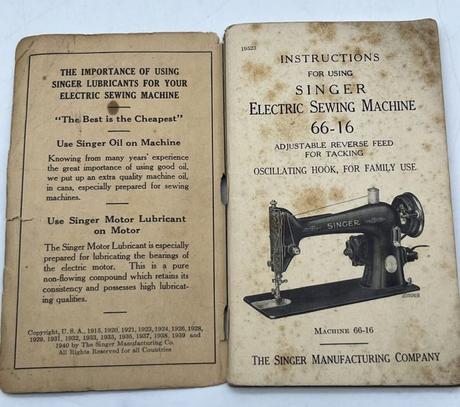 An instruction manual from the 1940s for Singer Model 66-16
An instruction manual from the 1940s for Singer Model 66-16Factories
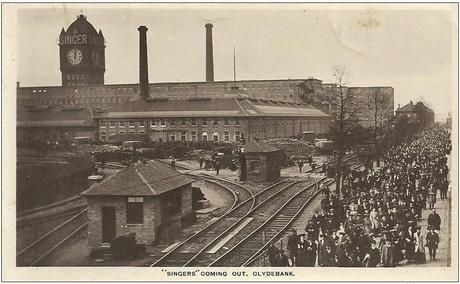 People leaving Singer Sewing Machine Factory, Clydebank (Scotland)Image from Wikimedia Commons
People leaving Singer Sewing Machine Factory, Clydebank (Scotland)Image from Wikimedia CommonsInitially, Singer’s sewing machines were produced in a small shop in Boston. As demand for sewing machines grew, Singer expanded production and established its first factory.
By 1860, Singer had become one of the largest sewing machine manufacturers in the world. To meet increasing demand, the company opened additional factories in the United States and abroad. In 1863 Singer moved to New York, and by 1872 it established a large factory in Elizabethport, New Jersey. This factory became one of the company’s primary manufacturing facilities and played a significant role in Singer’s expansion.
This factory, though, was also quickly outgrown, and after a temporary move to an intermediate site, a new factory was built on a 46 acre site in Kilbowie, Clydebank (Scotland). This factory, situated on the banks of the River Clyde, became one of the largest sewing machine factories in the world. It produced millions of sewing machines for both domestic and industrial use and played a crucial role in Singer’s global operations. Together with the Elizabethport factory, these two sites were the backbone of the Singer empire.
In addition to its factories in the United States and Scotland, Singer established manufacturing facilities in other countries, including Canada, Italy, France, and Germany. These factories produced sewing machines tailored to local markets and helped solidify Singer’s position as a leading global brand. Some of the smaller factories could make complete machines, but others more often just assembled the parts that were sent from the two main factories in Elizabethport and Kilbowie.
Many factories were allocated “Location Codes”, which appeared in model numbers to identify where the machines were made. They are not to be confused with the initial letters of serial codes, though.
At the beginning of the 20th century, Singer began adding letter prefixes to its serial numbers, each different letter allocated to one of the factories, the bigger ones having more than one letter prefix associated.
While many records were lost, mainly for the smaller factories, the registers for the Elizabethport and Kilbowie factory and more others were preserved. For some years, the PDF versions of those records were even publicly available on the official Singer website. Many other websites now share those tables, the ones by ISMACS the more accurate ones in my opinion.
Our own database is based upon the official Singer records as revised in 2005, with notes and info about factories thanks to ISMACS records and SingerSewingInfo.co.uk.
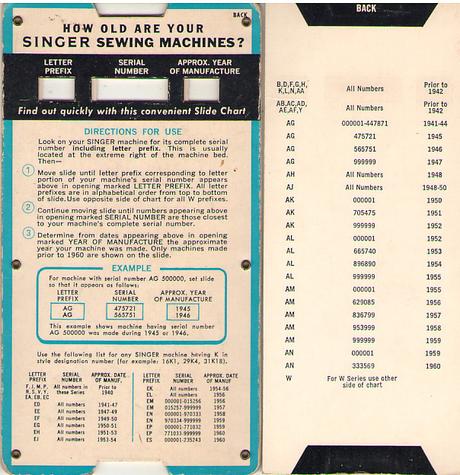 Singer serial number slide chart to date a machine by its serial number
Singer serial number slide chart to date a machine by its serial numberResources
- About Singer sewing machines serial numbers
- Factories and location codes
- Serial numbers from the official Singer website, no letter prefix (archived by Wayback Machine)
- Serial numbers from the official Singer website, one-letter prefix (archived by Wayback Machine)
- Serial numbers from the official Singer website, two-letter prefix (archived by Wayback Machine)
- Serial numbers and relative information, by ISMACS
- Location codes and serial number prefixes
- Manuals in PDF
More on our vintage Singer sewing machine
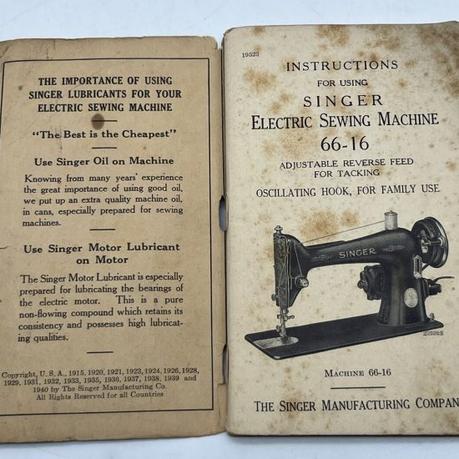
Find info on your Singer sewing machine
by Rici86.

